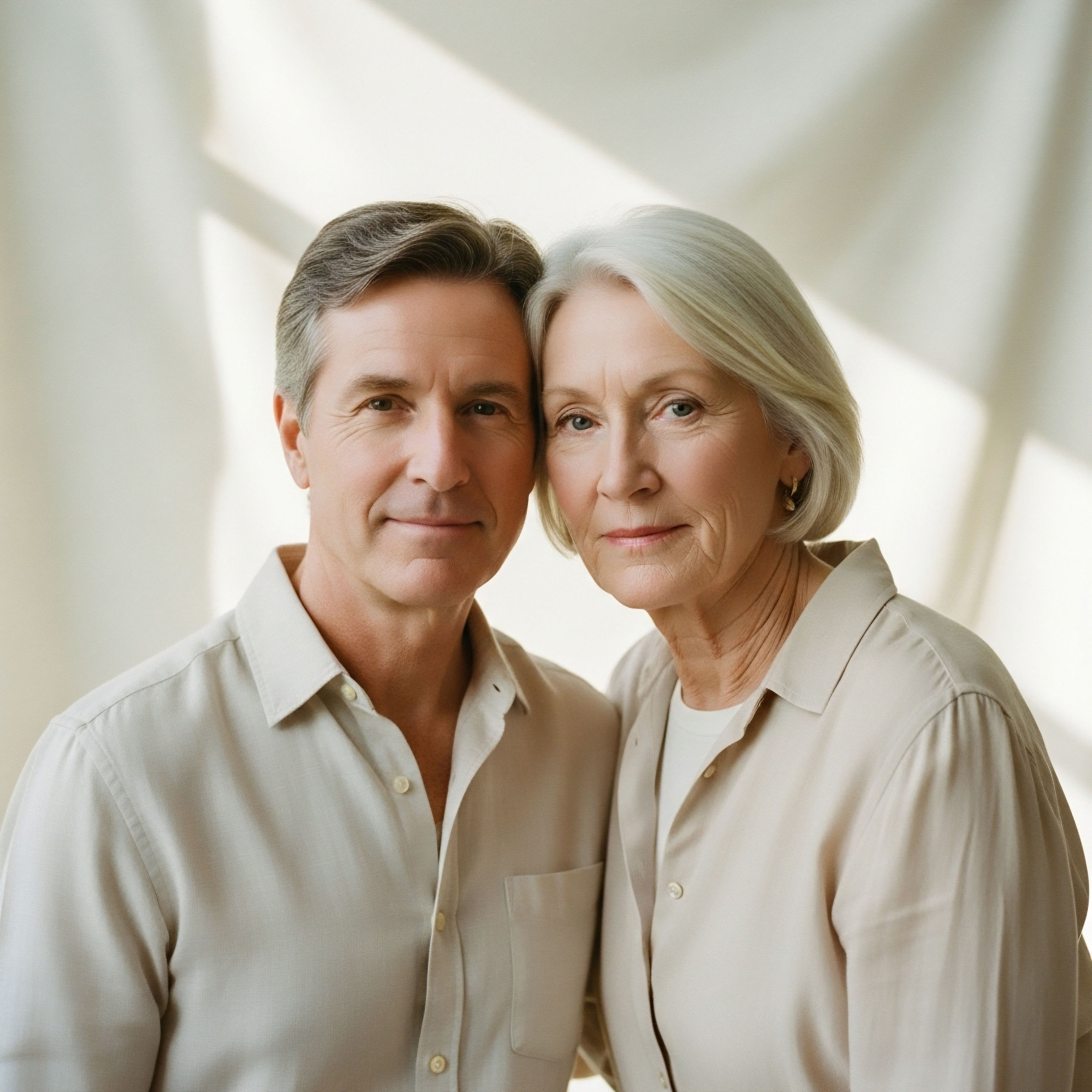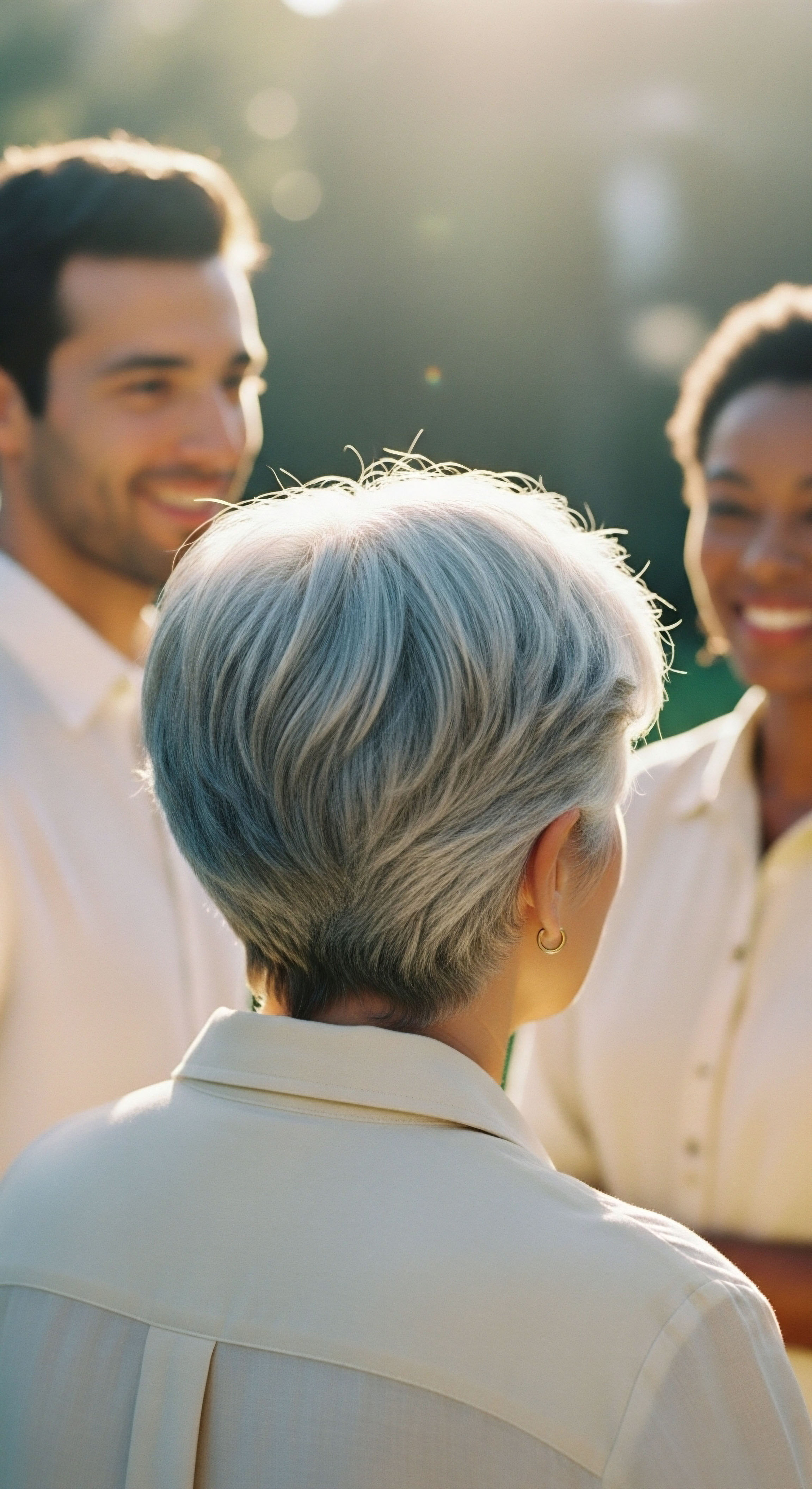

Fundamentals
Your experience of vitality, energy, and drive is deeply personal, yet it is orchestrated by a universal biological language ∞ the endocrine system. When considering a clinical protocol like testosterone therapy, particularly within the cultural context of China, we are not simply addressing a number on a lab report. We are engaging with a profound narrative about what it means to age, to be powerful, and to feel well.
The feelings of fatigue, mental fog, or a diminished sense of self are valid and real. Understanding their physiological origins is the first step toward reclaiming your function.
In China, the conversation around male vitality has been shaped for millennia by the principles of Traditional Chinese Medicine Meaning ∞ Traditional Chinese Medicine (TCM) is a comprehensive medical system developed in China over millennia. (TCM). Within this framework, the concept of Shen Jing, or “kidney essence,” is paramount. Shen Jing is viewed as the foundational source of life force, governing development, maturation, and fertility. A decline in vitality with age is often interpreted as a depletion of this vital essence.
This perspective fosters a view of aging as a natural, albeit challenging, process of depletion. The symptoms that a Western-trained physician might identify as clinical hypogonadism—low testosterone—are seen through a different lens, one of a systemic imbalance or deficiency in the body’s core energy reserves.
The cultural interpretation of aging in China, rooted in Traditional Chinese Medicine, shapes the initial approach to symptoms of hormonal decline.
This traditional viewpoint creates a unique landscape for the acceptance of modern hormonal therapies. Many men may first turn to herbal remedies or lifestyle adjustments prescribed by a TCM practitioner to nourish their Shen Jing. The idea of replacing a specific hormone, like testosterone, can seem mechanistic or foreign compared to the holistic goal of restoring systemic balance.
Therefore, the initial consultation in a clinical setting often involves bridging these two worlds. It requires a dialogue that respects the cultural understanding of vitality while introducing the precise, data-driven perspective of endocrinology.
The endocrine system itself operates on a principle of intricate balance, a concept that resonates with TCM’s holistic view. Your body’s production of testosterone is regulated by a sophisticated feedback loop known as the Hypothalamic-Pituitary-Gonadal (HPG) axis. The hypothalamus in your brain acts as a control center, sending signals to the pituitary gland, which in turn signals the testes to produce testosterone. When testosterone levels Meaning ∞ Testosterone levels denote the quantifiable concentration of the primary male sex hormone, testosterone, within an individual’s bloodstream. are sufficient, they send a message back to the brain to slow down the signaling.
It is a self-regulating system designed to maintain equilibrium. When symptoms arise, it is because this finely tuned system is no longer functioning optimally. The goal of a personalized wellness protocol is to identify the point of dysfunction and provide the necessary support to restore that delicate biochemical conversation.


Intermediate
When a man in China seeks medical advice for symptoms of declining vitality, the clinical pathway is influenced by a confluence of cultural norms, medical training, and economic factors. While a physician trained in Western medicine will focus on diagnosing late-onset hypogonadism Meaning ∞ Late-Onset Hypogonadism (LOH) is a clinical syndrome defined by a deficiency in serum testosterone levels in aging men, accompanied by specific symptoms. (LOH) through symptom evaluation and serum testosterone measurements, the patient’s own understanding is likely rooted in the concepts of TCM. This creates a critical need for the clinician to act as a translator, connecting the patient’s felt experience with objective biochemical data.

Bridging Traditional Beliefs and Clinical Data
The diagnostic process itself presents challenges. Standardized questionnaires used to screen for androgen deficiency, such as the Androgen Deficiency Meaning ∞ Androgen deficiency refers to a physiological state where the body produces insufficient levels of androgens, primarily testosterone, or when the body’s tissues exhibit inadequate responsiveness to these vital hormones. in Aging Males (ADAM) and Aging Males’ Symptoms (AMS) scales, have shown limited diagnostic value in Chinese populations. This suggests that the presentation of symptoms or their interpretation may differ culturally.
A physician must therefore rely more heavily on a thorough physical examination and, most importantly, on laboratory testing to establish a clear diagnosis of androgen deficiency. The conversation then shifts to explaining how a specific hormonal deficit, confirmed by blood work, is the physiological cause of the symptoms the patient attributes to “kidney essence” depletion.
Effective treatment in this context requires integrating objective hormonal data with a patient’s culturally-informed health beliefs.
Furthermore, there is a strong cultural preference to first attempt treatment with traditional remedies. Patients are often more willing to try TCM formulations aimed at tonifying the kidneys and boosting qi (vital energy) before considering a Western pharmaceutical intervention. A clinically-informed approach does not dismiss these beliefs but seeks to integrate them.
A physician might acknowledge the potential benefits of TCM for overall wellness while explaining that for a confirmed, significant testosterone deficiency, direct hormonal support is the most direct and effective way to restore physiological function. This requires a careful, respectful dialogue that empowers the patient with a comprehensive understanding of all available options.

Navigating Treatment Protocols in China
Once a diagnosis of hypogonadism is made and the patient is open to hormonal therapy, the practical aspects of treatment come to the forefront. The choice of protocol and its accessibility are shaped by the healthcare system and regulatory environment.
- Insurance and Cost ∞ A significant barrier is that in mainland China, androgen preparations are typically not reimbursable by Medicare for age-related hypogonadism (LOH). Reimbursement is generally restricted to cases where the hypogonadism is caused by a clear pathology of the hypothalamus, pituitary, or testes. This means that for many aging men, the cost of therapy is an out-of-pocket expense, which can be a substantial deterrent.
- Physician Awareness ∞ There is a documented lack of attention paid to the symptoms of androgen deficiency among both the general public and some medical specialists. This can lead to under-diagnosis and a reluctance to prescribe testosterone replacement therapy (TRT), even when clinically indicated. Urologists and andrologists are more likely than general practitioners or endocrinologists to prescribe testosterone.
- Therapeutic Options ∞ While various forms of testosterone are available, the specific protocols common in other parts of the world, such as combining TRT with agents like Gonadorelin or Anastrozole to manage the endocrine system holistically, may be less common or accessible. The focus is often on straightforward testosterone replacement.
The table below outlines the conceptual differences in approach that a clinician must navigate when discussing hormonal health with a patient in China.
| Aspect of Male Aging | Traditional Chinese Medicine Perspective | Western Clinical Endocrinology Perspective |
|---|---|---|
| Underlying Cause of Symptoms | Depletion of “Shen Jing” (kidney essence); imbalance of Yin and Yang. | Reduced testosterone production from the testes, disrupting the HPG axis. |
| Primary Diagnostic Method | Observation of tongue, pulse diagnosis, and symptom patterns. | Symptom questionnaires, physical exam, and serum testosterone blood tests. |
| Initial Treatment Approach | Herbal medicine, acupuncture, and lifestyle changes to nourish kidney essence. | Testosterone Replacement Therapy (TRT) to restore physiological hormone levels. |
| Concept of “Cure” | Restoring systemic harmony and balance of the body’s energies. | Managing a chronic condition by correcting a specific biochemical deficiency. |
Academic
The acceptance of testosterone therapy Meaning ∞ A medical intervention involves the exogenous administration of testosterone to individuals diagnosed with clinically significant testosterone deficiency, also known as hypogonadism. in China is a complex issue at the intersection of deep-seated cultural values, the architecture of the national healthcare system, and the global dissemination of biomedical knowledge. A thorough analysis reveals that the primary obstacles are not solely clinical but are embedded in the socio-medical fabric of the nation. Understanding this requires a systems-level view that incorporates public health, medical anthropology, and health economics.

What Are the Socio-Economic Barriers to TRT Adoption?
The economic and regulatory landscape presents formidable barriers to the widespread adoption of TRT for late-onset hypogonadism. The decision by China’s Medicare system not to reimburse androgen therapies for LOH is a critical factor. This policy effectively positions age-related hormonal decline as a non-pathological state, a “lifestyle” issue, rather than a treatable medical condition.
Consequently, TRT becomes a private-pay service, accessible primarily to a more affluent segment of the population. This economic stratification of care reinforces the cultural perception of such treatments as elective enhancements rather than medical necessities.
This situation creates a feedback loop. With low patient demand due to cost and cultural preference for TCM, there is less incentive for non-specialist physicians to gain expertise in hormonal optimization Meaning ∞ Hormonal Optimization is a clinical strategy for achieving physiological balance and optimal function within an individual’s endocrine system, extending beyond mere reference range normalcy. protocols. The lack of broad physician education and engagement means that even men who could afford the treatment may not be diagnosed correctly or offered it as a viable option. The medical community’s focus remains on classical hypogonadism resulting from verifiable organ pathology, leaving the much larger population of men with age-related functional decline underserved.
The regulatory decision to exclude late-onset hypogonadism from public insurance coverage fundamentally shapes both patient access and physician engagement with testosterone therapy.
Furthermore, the diagnostic criteria for LOH themselves remain a subject of academic debate within the region. While Western guidelines from organizations like the Endocrine Society provide clear cut-off points for serum testosterone, research in Asian populations suggests these may not be directly applicable. Studies have shown that both total and free testosterone levels can vary significantly by geography and race, even after adjusting for variables like Body Mass Index (BMI).
For instance, some studies indicate that men in Hong Kong and Japan have higher baseline testosterone levels than their Western counterparts. This necessitates the development of population-specific reference ranges and diagnostic criteria for Chinese men to avoid both over- and under-diagnosis, a complex task that requires large-scale epidemiological studies.

How Does Traditional Medicine Influence Modern Clinical Practice?
The enduring influence of Traditional Chinese Medicine is a defining feature of the Chinese healthcare landscape. TCM is not a fringe practice; it is integrated into the national health system, with public hospitals dedicated to its practice. Patients often use both systems concurrently, seeking a TCM diagnosis for the root “imbalance” while consulting a Western doctor for acute symptoms.
When it comes to LOH, a patient may receive a TCM diagnosis of “kidney yang deficiency” and be prescribed herbal formulas. The perceived efficacy of these traditional treatments can delay or prevent a patient from seeking a biomedical diagnosis.
This dual-track system has profound implications for clinical trials and pharmaceutical marketing. For a new TRT protocol to gain acceptance, it must demonstrate value not just against a placebo, but against a deeply ingrained, culturally trusted therapeutic tradition. Pharmaceutical companies must navigate a landscape where direct-to-consumer advertising is restricted, and physician education must be culturally sensitive.
The language used to describe the benefits of TRT must resonate with concepts of vitality and well-being without directly challenging the foundational principles of TCM. A successful approach often involves positioning TRT as a powerful, targeted tool that can work alongside or as a next step after traditional methods have been attempted.
The table below details some of the specific biochemical and clinical considerations that are pertinent in the academic discussion of TRT in China.
| Parameter | Clinical Consideration in the Chinese Context | Supporting Evidence/Rationale |
|---|---|---|
| Serum Testosterone Cut-Offs | Standard Western diagnostic thresholds for LOH may not be appropriate. Population-specific data is needed. | Studies show significant geographical and racial variation in baseline sex steroid levels. |
| Screening Questionnaires | ADAM and AMS scales have demonstrated low sensitivity and specificity in Chinese men. | Cultural differences in symptom reporting and interpretation likely reduce the utility of these tools. |
| Patient Preference | A significant portion of the population prefers or will first try Traditional Chinese Medicine. | Cultural tradition and the holistic philosophy of TCM are deeply ingrained. |
| Economic Accessibility | TRT for LOH is generally not covered by public insurance, making it a private expense. | Medicare reimbursement is limited to hypogonadism from specific organic pathologies. |
References
- Gu, Y. & Zhang, M. (2018). Testosterone replacement therapy ∞ dilemmas and challenges in China and Asia. Asian Journal of Andrology, 20(2), 114–117.
- Wu, F. C. W. Tajar, A. Pye, S. R. Silman, A. J. Finn, J. D. O’Neill, T. W. Bartfai, G. Casanueva, F. Forti, G. Giwercman, A. Huhtaniemi, I. T. Kula, K. Punab, M. & Vanderschueren, D. (2008). Hypothalamic-pituitary-testicular axis disruptions in older men are differentially linked to age and modifiable risk factors ∞ the European Male Aging Study. The Journal of Clinical Endocrinology & Metabolism, 93(7), 2737–2745.
- Travison, T. G. Morley, J. E. Araujo, A. B. O’Donnell, A. B. & McKinlay, J. B. (2006). The relationship between libido and testosterone levels in aging men. The Journal of Clinical Endocrinology & Metabolism, 91(7), 2509–2513.
- Orwoll, E. S. Lambert, L. C. Marshall, L. M. Phipps, K. Sherman, S. & Pye, S. R. (2006). Evidence for geographical and racial variation in serum sex steroid levels in older men. The Journal of Clinical Endocrinology & Metabolism, 91(4), 1316–1322.
- Liu, P. P. Liu, T. & Zhu, X. W. (2020). The prevalence of late-onset hypogonadism and its relationship with metabolic syndrome in aging Chinese males. Asian Journal of Andrology, 22(2), 163–167.
- Han, C. Wang, Y. & Geng, L. (2018). Single dose testosterone administration increases men’s facial femininity preference in a Chinese population. Psychoneuroendocrinology, 90, 109-113.
Reflection
The exploration of testosterone therapy in China offers a powerful lens through which to view our own health paradigms. Your body is communicating its needs through the language of symptoms. The path to understanding this language is shaped by the culture you live in, the medical systems you have access to, and the personal beliefs you hold about aging and vitality. The knowledge you have gained is a foundational tool.
It allows you to ask more precise questions and to engage with healthcare providers as a partner in your own wellness journey. The ultimate goal is to synthesize this external information with your internal experience, creating a personalized protocol that restores not just a number, but your unique sense of well-being and function.





